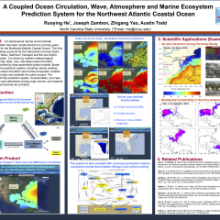A Coupled Ocean Circulation, Wave, Atmosphere and Marine Ecosystem Prediction System for the IAS
Ruoying
He
North Carolina State University
Poster
A 3-dimensional marine environmental prediction system has been constructed and is running quasi-operationally for the Intra-Americas Seas. This fully coupled modeling accounts for the interactions among Ocean, Atmosphere, Wave, Sediment Transport and the low-trophic marine ecosystem. It is driven by realistic meteorological boundary forcing, tides, river, and deep-ocean boundary conditions provided by a data assimilative global ocean model. Model output from this prediction system, including marine weather, ocean wave, ocean circulation and marine ecosystem variable are generated daily and available for public access. The construction of this prediction system, model validations and case studies on air-sea interactions during major tropical and extratropical storms will be discussed in this presentation.

Poster 12.pdf
(968.53 KB)
Session V: Identifying sources of model biases for the IAS in both coupled and ocean or atmospheric models

Number of comments: 5
Comments
Comment by: Chunzai Wang
September 4, 2015 - 11:29am
Ruoying:
Thank you for your good work. This kind of coupled models is very important for studying and monitoring the IAS and extreme events such as hurricanes. However, the regional coupled model can not simulate large-scale climate variations (for example, ENSO events) which largely influence extreme events. Hope that the community can develop coupled models that can simulate both small-scale and large-scale variations.
Chunzai
Comment by: Ruoying He
September 7, 2015 - 3:24pm
Chuanzai,
Thanks much for your comments. Our coupled regional modeling system is nested inside global models. We have been using global GFS, HYCOM, WWIII to provide realistic open boundary conditions for our regional atmosphere, ocean and wave models, respectively. So the large-scale climate variations are being accounted for to the degree by which these global models are capable of producing.
I agree with you that we need to play close attention to air-sea-wave coupling in studying IAS marine environment, extreme events and their long-term variability. We look forward to working with others in the community to advance the state of the art of coupled modeling in addressing IAS climate variability and prediction problems.
Ruoying
Comment by: Vasu Misra
September 10, 2015 - 12:36pm
Ruoying,
This is very encouraging to see WRF being developed as an regional Earth system model. But I was wondering if you have run this model for a long period of time and examined the simulated climate. Also when you run this for short-term forecasts, are you using any specialized initial conditions or are you interpolating it to your regional grid from the large-scale conditions.
Comment by: Ruoying He
September 10, 2015 - 12:53pm
Thanks Vasu, we have been running the coupled modeling system over the synoptic and seasonal time scales, but haven't tried to run it further longer. Having said that, long-term coupled simulation has always been one of our plans, but it would require a significant amount of computing power that we are yet to secure.
Regarding your question about the initial conditions, we obtain them from global models (GFS, HYCOM, WWIII). Each short-term coupled forecast begins with a week or so hindcast to allow the coupled system to dynamically digest initial conditions and spin up.
Ruoying
Comment by: Christian Dominguez
September 11, 2015 - 1:20pm
Hi Ruoying He,
Very interesting work!, have you analyzed other hurricanes apart from Sandy?
I am curious, is the coupled model be able to capture the tropical cyclogenesis region 5-7 days ahead? Have you analyzed the OHC during the tropical cyclogenesis?
Not accepting new comments